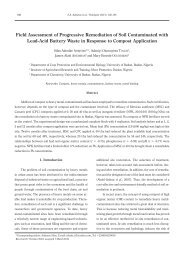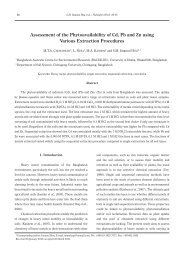Land Degradation and Pedological Processes in a Changing Climate
Land Degradation and Pedological Processes in a Changing Climate
Land Degradation and Pedological Processes in a Changing Climate
- No tags were found...
You also want an ePaper? Increase the reach of your titles
YUMPU automatically turns print PDFs into web optimized ePapers that Google loves.
316R. Lal / Pedologist (2012) 315-325the importance of the pedological processes affect<strong>in</strong>g l<strong>and</strong>degradation <strong>in</strong> a chang<strong>in</strong>g climate characterized by a rise<strong>in</strong> temperature, change <strong>in</strong> precipitation, <strong>and</strong> an <strong>in</strong>crease <strong>in</strong>the frequency of extreme events.2. Basic ConceptsThe processes of l<strong>and</strong> <strong>and</strong> soil degradation are set<strong>in</strong>-motionby the loss of equilibrium of a stable soil due tonatural <strong>and</strong>/or anthropogenic factors. “<strong>L<strong>and</strong></strong> degradation”refers to the loss of climax vegetation <strong>and</strong> its replacementby secondary vegetation with an adverse impact on soilquality <strong>and</strong> ecosystem services. In contrast, the term “retrogression”literally means transformation from a complexto a simpler biological form lead<strong>in</strong>g to degeneration, abiotrophy,or change from one state to another through naturalor anthropogenic factors, lead<strong>in</strong>g to an adverse impacton the quality of the upper soil horizon. The process ofretrogression, caused for example by accelerated erosion,may be partial or total <strong>and</strong> is <strong>in</strong>itiated by events such asdeforestation, biomass burn<strong>in</strong>g, overgraz<strong>in</strong>g, <strong>and</strong> plow<strong>in</strong>g.The term “desertification” is degradation of l<strong>and</strong> <strong>in</strong> arid<strong>and</strong> dry sub-humid areas lead<strong>in</strong>g to a decl<strong>in</strong>e <strong>in</strong> ecosystemfunctions <strong>and</strong> services. Drought is a dom<strong>in</strong>ant processdriv<strong>in</strong>g desertification <strong>and</strong> can be one of three types: (i)meteorological drought caused by a long-term decl<strong>in</strong>e <strong>in</strong>precipitation, (ii) hydrological drought caused by a reduction<strong>in</strong> surface runoff <strong>and</strong> fall <strong>in</strong> the water table, <strong>and</strong> (iii)pedological drought caused by a decl<strong>in</strong>e <strong>in</strong> soil moistureavailability. <strong>L<strong>and</strong></strong> degradation, especially desertification,affects all three types of drought, but the effects of pedologicaldrought are observed long before those of meteorological<strong>and</strong> hydrological drought. In contrast to l<strong>and</strong>degradation, the term “soil degradation” refers to the decl<strong>in</strong>e<strong>in</strong> the quality <strong>and</strong> capacity of soil’s productivity dueboth to natural <strong>and</strong> anthropogenic factors. Soil degradationis caused by natural <strong>and</strong> anthropogenic perturbations <strong>in</strong>the hydrological cycle, nutrient/elemental cycl<strong>in</strong>g, energybudget, <strong>and</strong> activity <strong>and</strong> species diversity of soil biota.In the steady state, the pedosphere is <strong>in</strong> dynamicequilibrium with its environment, which comprises the atmosphere,hydrosphere, biosphere, <strong>and</strong> lithosphere (Fig.1). This dynamic equilibrium can be disturbed by naturalevents such as volcanic eruptions, wild fires, flash floods,<strong>and</strong> mass movement. In contrast to natural perturbations,the delicate <strong>and</strong> dynamic equilibrium is also disturbed byanthropogenic activities such as deforestation, l<strong>and</strong> useconversion, dra<strong>in</strong>age of wetl<strong>and</strong>s, biomass burn<strong>in</strong>g, farm<strong>in</strong>gpractices, plow<strong>in</strong>g, <strong>and</strong> use of agrochemicals. The perturbedpedosphere is prone to accelerated erosion (Lal,2001; Pimentel et al., 1995) <strong>and</strong> undergoes a change ofstate <strong>in</strong> response to events such as loss of topsoil, decl<strong>in</strong>e<strong>in</strong> SOM <strong>and</strong> nutrient content, disruption <strong>and</strong> changes <strong>in</strong>elemental <strong>and</strong> hydrologic cycl<strong>in</strong>g <strong>and</strong> balance, alterations<strong>in</strong> energy budget, disruption <strong>in</strong> <strong>in</strong>tra-solum processes,shift <strong>in</strong> activity, <strong>and</strong> species diversity of biota. Thus, thechange <strong>in</strong> l<strong>and</strong> use <strong>and</strong> l<strong>and</strong> cover must be undertaken bythose practices which cause the least disturbance to thepedosphere <strong>and</strong> its environment (Fig. 1; lithosphere, atmosphere,hydrosphere, <strong>and</strong> biosphere).3. <strong>Processes</strong>, Factors, <strong>and</strong> Causes Lead<strong>in</strong>g toPerturbation of the Pedosphere <strong>and</strong> the Attendant<strong>L<strong>and</strong></strong> <strong>Degradation</strong><strong>Processes</strong> are the mechanisms, drivers, source ofrequired energy, <strong>and</strong> the pr<strong>in</strong>cipal controls which lead toperturbations through disturb<strong>in</strong>g the delicate <strong>and</strong> dynamicequilibrium <strong>and</strong> set-<strong>in</strong>-motion the l<strong>and</strong>/soil degradationprocess which adversely affects ecosystem functions <strong>and</strong>services. Strongly <strong>in</strong>teractive pedological processes whichare impacted by degradation <strong>in</strong>clude: physical (weather<strong>in</strong>g,fractionation, sedimentation, translocation, deposition),chemical (dissolution, precipitation, acidification,carbonation), biological (respiration, m<strong>in</strong>eralization, humification),<strong>and</strong> ecological (shift <strong>in</strong> climax vegetation, change<strong>in</strong> l<strong>and</strong> forms <strong>and</strong> terra<strong>in</strong>, alterations <strong>in</strong> dra<strong>in</strong>age density<strong>and</strong> patterns). Factors are environmental parameters, attributes,<strong>and</strong> characteristics, which moderate the direction<strong>and</strong> magnitude of biophysical processes <strong>and</strong> alter theparameters lead<strong>in</strong>g to predom<strong>in</strong>ance of one process overthe others (i.e., physical, chemical, biological, <strong>and</strong> ecological).Pr<strong>in</strong>cipal factors <strong>in</strong>clude climate <strong>and</strong> terra<strong>in</strong>, <strong>in</strong>clud<strong>in</strong>gslope (length, steepness, shape aspect, regularity,complexity). Causes of l<strong>and</strong> degradation are those whichalter <strong>and</strong> moderate the effect of factors on pedosphericdegradation <strong>and</strong> are related to change <strong>in</strong> l<strong>and</strong> use <strong>and</strong> l<strong>and</strong>management. The important causes, which also govern












